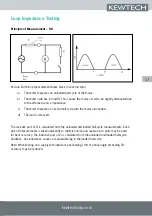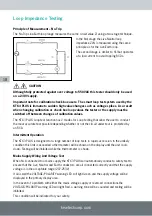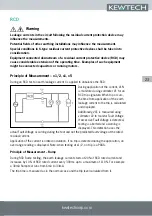
kewtechcorp.com
19
kewtechcorp.com
Loop Test Procedures
Hands Free Loop Testing
The hands free feature can be used in either No Trip or high current test modes.
To enable the hands free feature simply press the ‘HANDS FREE’ button once, The ‘HANDS FREE’
annunciator will appear flashing on the display and will continue to do so until cancelled by a
further press of the ‘HANDS FREE’ button or by changing the function selector switch.
When the ‘HANDS FREE’ annunciator is flashing all you need to do is connect the test lead to a
mains supply and the test will be carried out.
High Current Mode
For Ze testing at the distribution board or at any point upstream of RCD protection there is
a traditional fast high current test mode. The high current mode is a 2-wire test that enables
the user to test the true impedance of both the Line-Neutral Loop and the Line-Earth loop and
therefore to establish both the PSC (prospective short circuit current) and the PFC (prospective
fault current) for the installation.
Unlike most testers that only measure the resistance of the Loop, the high current mode of the
KT63 PLUS will measure the impedance of the Loop which includes an element of reactance.
This can be significant where the distribution board is close to the mains supply transformer and
is therefore much more accurate than older Loop testing techniques.
You should be aware that because of this there may well be variations in reading compared to
ordinary loop testers or to the non-trip function of this tester, particularly when the measurement
is made near to the mains supply transformer.
No Trip Mode
For Zs testing where the circuit being tested is protected by an RCD there is the No Trip Loop
Test mode. In this mode testing can be made at sockets on the final circuit without fear of
tripping the RCD under normal circumstances.
This is achieved by testing at a current that is too low to trip an RCD on an otherwise healthy
circuit. The No Trip test is a 3-wire test that also checks the Live, Neutral/Earth conductors are
correctly connected before running the loop test.
Note- if there is abnormal standing leakage current on the circuit such as a faulty Microwave
Cooker for example then this abnormal leakage is added to low current used for the above test
and the RCD may trip.
However this can be seen as an advantage since it is pointing to a faulty appliance that should
be rectified or replaced.




























